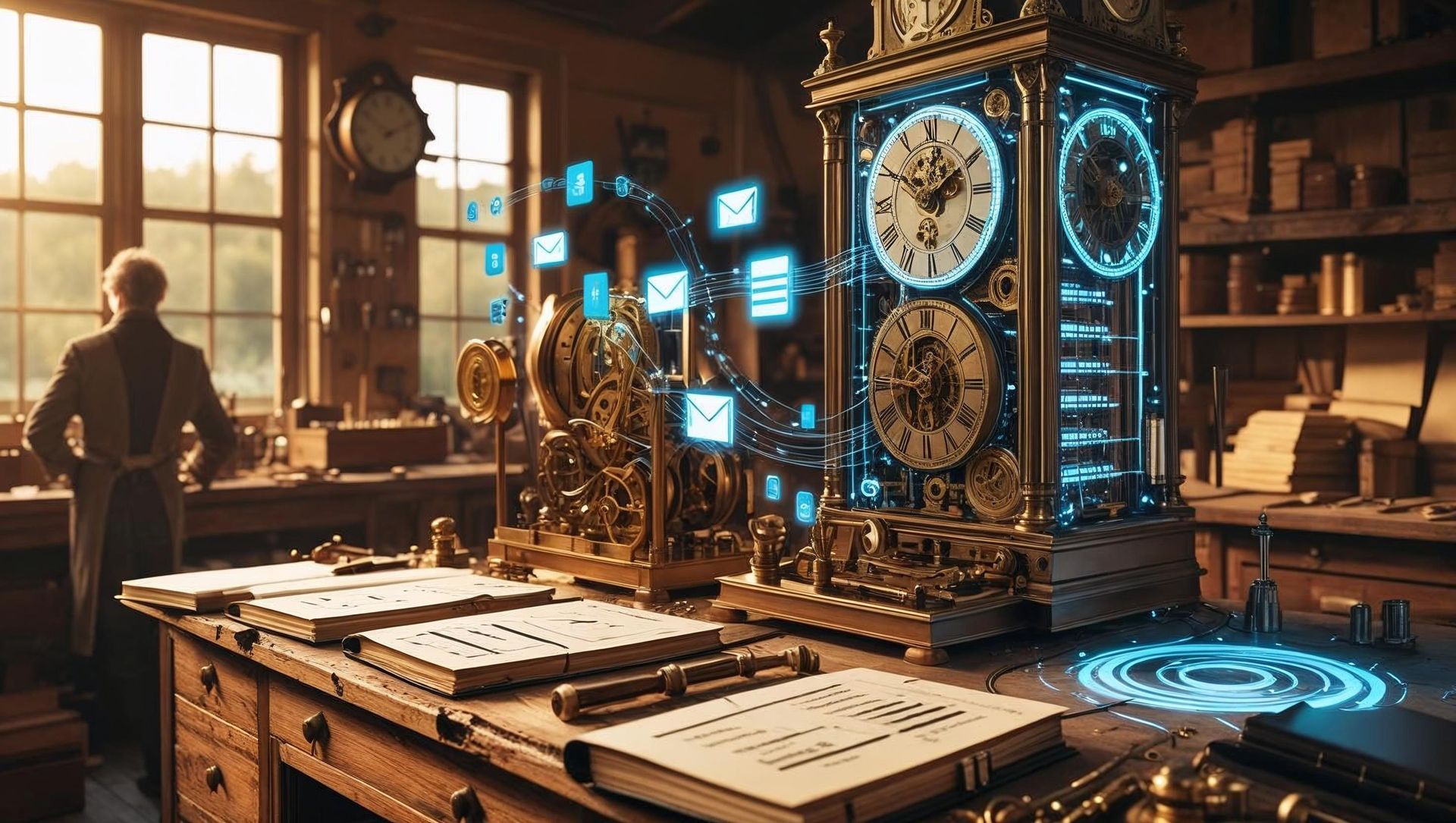AI + Automation: Synergistic Strategies for Next-Level Productivity
The automation tools we've relied on for years are getting a major upgrade. While traditional automation excels at following rules and executing repetitive tasks, it stumbles when faced with messy data, ambiguous decisions, or situations requiring judgment. Enter artificial intelligence, the missing ingredient that transforms rigid workflows into adaptive, intelligent systems that actually think.
This isn't just about slapping a chatbot onto your existing processes. The real opportunity lies in understanding where AI-enhanced automation creates exponential value versus incremental improvement. For small and medium-sized businesses, this distinction matters enormously. Done right, smart automations unlock capabilities that were previously impossible without significant human resources.
Beyond Simple Triggers: What Makes Automation "Smart"
Traditional automation follows IF-THIS-THEN-THAT logic. A form submission triggers an email. A calendar event creates a task. These workflows break down the moment they encounter exceptions, variations, or data that doesn't fit the expected format.
Smart automation, powered by AI, handles the gray areas:
Data inconsistency? AI can standardize and clean information on the fly. Instead of rejecting a lead form because someone wrote "NYC" instead of "New York," the system understands the intent and routes accordingly.
Contextual decisions? Machine learning models can evaluate multiple factors simultaneously (lead quality, timing, previous interactions, market conditions) and make nuanced routing decisions that would require complex decision trees in traditional automation.
Natural language processing? Systems can now extract meaning from unstructured text, whether that's categorizing support tickets, pulling key details from emails, or summarizing lengthy documents.
The synergy emerges when you combine automation's speed and consistency with AI's ability to interpret, adapt, and learn.
Real-World Applications: Where Smart Automation Shines
Let's move beyond theory and examine where this combination delivers measurable impact.
Intelligent CRM Data Management
Customer relationship management systems are notoriously messy. Sales teams enter data inconsistently, duplicates proliferate, and critical information hides in email threads and meeting notes.
An AI-enhanced workflow might work like this: When a contact enters your CRM, an AI model analyzes the data quality, identifies potential duplicates using semantic matching (not just exact matches), enriches the record by pulling information from LinkedIn or company websites, and categorizes the lead based on multiple signals. Only clean, enriched data makes it into your automation flows for nurturing sequences or sales assignments.
The result? Your marketing automation doesn't send three versions of the same email to slight variations of the same person. Your sales team doesn't waste time on leads that AI has already identified as poor fits based on patterns invisible to simple rule-based filters.
Adaptive Client Screening and Qualification
Service-based businesses often spend significant time on discovery calls with prospects who ultimately aren't good fits. Traditional intake forms capture basic information, but can't have conversations or probe deeper based on responses.
Smart automation changes this dynamic. An AI agent can conduct preliminary qualification conversations via chatbot or even voice, asking follow-up questions based on previous answers, identifying red flags or ideal-fit signals, and summarizing findings for human review. The system learns which characteristics predict successful client relationships and continuously refines its screening criteria.
This ensures your team only invests their time where it matters most.
Personalized Follow-Up at Scale
Every marketer knows personalization improves response rates, but true personalization requires understanding context, history, and individual preferences. Traditional mail merge can insert a first name; AI can craft genuinely relevant messages.
Consider an automated report generation system enhanced with AI. Rather than sending every client the same template with their numbers plugged in, the system analyzes the data, identifies significant trends or anomalies, generates narrative explanations of what the numbers mean, and even suggests actions based on the specific client's goals and previous behavior. Each report feels personally crafted because, in a sense, it is, just at machine speed and scale.
Predictive Workflow Optimization
The most sophisticated application is orchestrating entire processes that adapt based on predicted outcomes. Machine learning models can forecast which leads are most likely to convert, which support tickets will escalate, or which invoices will require follow-up. Your automation then allocates resources accordingly: routing high-probability leads to your best closers, flagging potentially problematic tickets for senior staff, or triggering preemptive outreach for accounts showing payment friction.
These predictive elements transform reactive workflows into proactive systems that anticipate needs and problems before they fully materialize.
The Rise of AI Agents: Automation's Next Evolution
Recent developments in AI agents (autonomous systems that can plan, execute multi-step tasks, and interact with various tools) represent a quantum leap in what's possible with intelligent automation.
Unlike traditional automations that follow predetermined paths, AI agents receive objectives and figure out how to accomplish them. Need to research a prospect, update your CRM, schedule a meeting, and draft a personalized outreach email? An AI agent can chain those tasks together, making decisions at each step based on what it discovers.
For SMBs, this matters because it democratizes capabilities that previously required custom software development or large operational teams. You're no longer limited to the workflows you can explicitly design, you can deploy agents that accomplish goals even when the path varies case by case.
Strategic Implementation: Where to Start
The potential is exciting, but the key question remains: where should your business actually deploy smart automation?
Start with high-volume, high-variation processes. The sweet spot for AI-enhanced automation is tasks you perform frequently but that require some judgment or adaptation each time. Customer intake, content categorization, data enrichment, and preliminary analysis all fit this profile.
Identify your "messy data" bottlenecks. Look for places where your current automations fail or where you're manually cleaning, standardizing, or interpreting information before it can flow through systems. These friction points are prime candidates for AI intervention.
Focus on decision support, not decision replacement. The most successful implementations augment human expertise rather than attempting to eliminate it entirely. Use AI to surface insights, generate drafts, and flag exceptions, then let humans apply final judgment for critical decisions.
Build learning loops. The "smart" in smart automation comes from continuous improvement. Implement feedback mechanisms so your AI models learn from corrections, successful outcomes, and changing business conditions. Static AI isn't much better than traditional automation.
Consider the cost-benefit carefully. AI capabilities involve more complexity and often higher costs than simple automation. Calculate not just time saved but also quality improvements, new capabilities unlocked, and potential scale-up without proportional headcount increases.
Common Pitfalls to Avoid
The enthusiasm around AI can lead businesses astray. Watch for these missteps:
Over-automating prematurely. Not everything benefits from AI enhancement. Simple, stable processes are often best handled with traditional automation. Add complexity only where it delivers clear value.
Neglecting data quality. AI models are only as good as their training data. If your underlying information is fundamentally flawed or biased, smart automation will amplify those problems rather than solve them.
Forgetting the human element. Clients and team members notice when they're interacting with systems rather than people. Be transparent about AI usage, and ensure seamless escalation to humans when situations require genuine empathy, creativity, or authority.
Implementing without monitoring. AI models can develop blind spots or drift away from optimal performance over time. Regular auditing and human oversight remain essential, especially for decisions with significant impact.
Looking Ahead: The Evolving Landscape
The trajectory is clear: AI capabilities will continue advancing while simultaneously becoming more accessible to non-technical users. We're moving toward a future where describing what you want to accomplish is nearly as easy as building the workflow to do it.
For SMBs, this creates an unusual window of opportunity. Large enterprises have more resources but also more legacy systems and organizational inertia. Smaller, more agile businesses can adopt smart automation practices now and build a significant operational advantage.
The question is whether your business will be an early adopter that shapes these tools to your advantage or a late follower scrambling to catch up.
Making It Actionable
Smart automation isn't a distant future concept. The tools exist today. The question is strategy: identifying where the combination of AI and automation creates genuine leverage for your specific business model.
Start by auditing your current workflows. Where do they break down? Where does manual intervention regularly occur? Where could better data quality or contextual decision-making dramatically improve outcomes? These friction points are your roadmap.
Then begin small. Pilot AI-enhanced automation in a single, well-defined area. Measure the impact rigorously. Learn what works in your unique context. Iterate and expand based on proven results rather than theoretical potential.
The businesses that will thrive are the ones that thoughtfully integrate intelligence where it multiplies human capability, creating workflows that are faster, smarter, and more adaptive than what came before.
The productivity gains from smart automation are step-function changes that fundamentally alter what's possible with your existing team. That's not hype. That's the measurable reality for businesses already making this shift.
The synergy between AI and automation is here. How quickly will you harness it?
© Virtual Rani2025. The information contained herein is provided for information purposes only; the contents are not intended to amount to advice and you should not rely on any of the contents herein. We disclaim, to the full extent permissible by law, all liability and responsibility arising from any reliance placed on any of the contents herein.














































































































